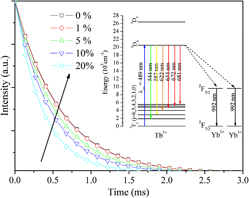Crossref Citations
This article has been cited by the following publications. This list is generated based on data provided by
Crossref.
Yang, Fugui
2012.
The spectroscopic investigation of ZnWO4: Yb3+ single crystal.
Journal of Materials Research,
Vol. 27,
Issue. 16,
p.
2096.
Pan, Z.
Sekar, G.
Akrobetu, R.
Mu, R.
and
Morgan, S.H.
2012.
Visible to near-infrared down-conversion luminescence in Tb3+ and Yb3+ co-doped lithium–lanthanum–aluminosilicate oxyfluoride glass and glass-ceramics.
Journal of Non-Crystalline Solids,
Vol. 358,
Issue. 15,
p.
1814.
Sun, Jiayue
Sun, Yining
Cao, Chun
Xia, Zhiguo
and
Du, Haiyan
2013.
Near-infrared luminescence and quantum cutting mechanism in CaWO4:Nd3+, Yb3+.
Applied Physics B,
Vol. 111,
Issue. 3,
p.
367.
Sun, Jiayue
Zhou, Wei
Sun, Yining
and
Zeng, Junhui
2013.
Broadband near-infrared downconversion luminescence in Eu2+–Yb3+ codoped Ca9Y(PO4)7.
Optics Communications,
Vol. 296,
Issue. ,
p.
84.
Wang, Zhaofeng
Li, Yezhou
Liu, Xiong
Wei, Xingmin
Chen, Yueling
Zhou, Fei
and
Wang, Yuhua
2014.
Photoluminescence performance of thulium doped Li 4 SrCa(SiO 4 ) 2 under irradiation of ultraviolet and vacuum ultraviolet lights.
Materials Research Bulletin,
Vol. 59,
Issue. ,
p.
295.
Zhao, Lei
Han, Lili
and
Wang, Yuhua
2014.
Efficient near-infrared down-conversion in KCaGd(PO_4)_2:Ce^3+,Yb^3+.
Optical Materials Express,
Vol. 4,
Issue. 7,
p.
1456.
Liu, Zijun
Li, Jinyan
Yang, Luyun
Chen, Qiaoqiao
Chu, Yingbo
and
Dai, Nengli
2014.
Efficient near-infrared quantum cutting in Ce3+–Yb3+ codoped glass for solar photovoltaic.
Solar Energy Materials and Solar Cells,
Vol. 122,
Issue. ,
p.
46.
Piskuła, Z.
Czajka, J.
Staninski, K.
and
Lis, S.
2014.
Luminescence properties of calcium tungstate activated by lanthanide(III) ions.
Journal of Rare Earths,
Vol. 32,
Issue. 3,
p.
221.
Yuan, Shuanglong
Zeng, Huidan
Wu, Xuanshun
Liu, Zhao
Ren, Jing
Chen, Guorong
Wang, Zhaofeng
and
Sun, Luyi
2014.
Significant enhancement of visible up-conversion emissions of Y2O2S:Er3+ phosphors by Mn2+ sensitizing under 1550 nm excitation.
RSC Adv.,
Vol. 4,
Issue. 32,
p.
16710.
Wang, Zhaofeng
Li, Yezhou
Jiang, Qi
Zeng, Huidan
Ci, Zhipeng
and
Sun, Luyi
2014.
Pure near-infrared to near-infrared upconversion of multifunctional Tm3+ and Yb3+ co-doped NaGd(WO4)2 nanoparticles.
J. Mater. Chem. C,
Vol. 2,
Issue. 22,
p.
4495.
Wang, Siqin
Qiu, Jianbei
Wang, Qi
Zhou, Dacheng
and
Yang, Zhengwen
2015.
Energy transfer and visible–infrared quantum cutting photoluminescence modification in Tm-Yb codoped YPO_4 inverse opal photonic crystals.
Applied Optics,
Vol. 54,
Issue. 22,
p.
6827.
Zhang, Gongguo
Cui, Qiuyu
and
Liu, Guodong
2016.
Efficient near-infrared quantum cutting and downshift in Ce3+-Pr3+ codoped SrLaGa3S6O suitable for solar spectral converter.
Optical Materials,
Vol. 53,
Issue. ,
p.
214.
PAN, Yu
LI, Li
CHANG, Wenxuan
CHEN, Wuyang
LI, Chen
CHEN, Peng
and
ZENG, Ziyu
2017.
Efficient near-infrared quantum cutting in Tb3+,Yb3+ codoped LuPO4 phosphors.
Journal of Rare Earths,
Vol. 35,
Issue. 3,
p.
235.
Xu, Jiating
Gulzar, Arif
Yang, Piaoping
Bi, Huiting
Yang, Dan
Gai, Shili
He, Fei
Lin, Jun
Xing, Bengang
and
Jin, Dayong
2019.
Recent advances in near-infrared emitting lanthanide-doped nanoconstructs: Mechanism, design and application for bioimaging.
Coordination Chemistry Reviews,
Vol. 381,
Issue. ,
p.
104.
Somasundaram, K.
Rastogi, Chandresh Kumar
Roy, Indrani
Selvin, P. Christopher
and
Sudarsan, V.
2019.
Lanthanide ion induced phase decomposition of tetragonal CaWO4.
Materials Research Bulletin,
Vol. 113,
Issue. ,
p.
133.





